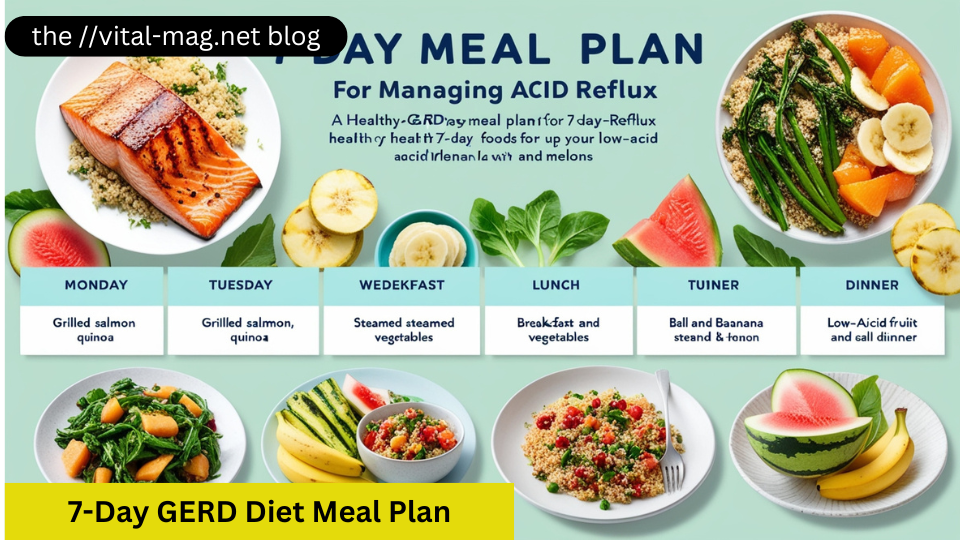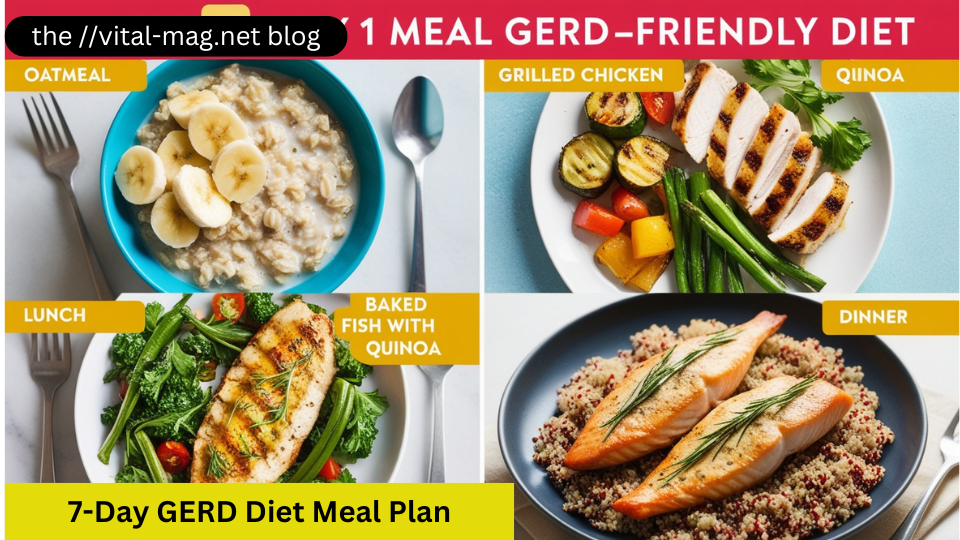Food management is key in how patients with GERD are thick and where the foods they take are directed in their bodies. Whilst following a well-developed plan that is GERD friendly, symptoms of heartburn and acid reflux can be contained. This 7-day GERD diet plan is intended to reduce discomfort yet satisfactory nutrition is obtained, with use of non-irritating foods.
GERD or gastroesophageal reflux disease most commonly known as acid reflux is when stomach contents are too far as head movement forward and the stomach the sphincter remains relaxed. Gradually this can lead to annoying heartburn, regurgitation of food and liquids, and a bitter or sour taste in the mouth. In such patient populations, the use of medications, although it is certainly of benefit.
This 7-day GERD diet plan is a well-organized approach to all those struggling with GERD and therefore, is creative in avoiding most of the triggers and making meals less distressing on the gastrointestinal tract. This involves outlining the types of foods to avoid and those to include as well as suggestions on how to adapt the plan to suit one’s tolerances.
Let’s begin with increasing the level of your order and eliminating issues of acid reflux, without medicine, diet.
Key Points:
- GERD Overview: A brief explanation of what GERD means and how it affects people on a daily basis.
- Dietary Approach: Identifying foods that cause GERD and those that relieve its symptoms.
- 7-Day Structure: Description of the meals that plan to limit the effect of heartburn on a daily basis.
- Customizable Options: Change the regime according to individuals’ toleration.

What is GERD?
The term GERD, short for gastroesophageal reflux disease, describes a long standing illness where stomach acids back up into the esophagus and cause pain to the patient. There is usually a weak linkage, which holds the stomach against the esophagus called lower esophageal sphincter, LES, which is the primary cause of this problem. When this muscle is too weak or ends up being abused and relaxed too much, stomach contents like acid can be indeed in the esophagus.
• Common Symptoms: Symptoms generally include heartburn (including a burning sensation in the chest), regurgitation, and post eating discomfort. Chronic cases of GERD can also cause chest pain, cough, and trouble swallowing food.
• Link Between Diet and GERD: There are foods which can relax the lower esophageal sphincter LES or increase acid production worsening the symptoms. Certain foods are best to be avoided and especially the ones that contribute or have been known to cause GERD so that the incidences of acid reflux become lower accordingly.
Statistics: Many than 20% of the U.S. population suffers from GERD, which shows how wide-spread the problem is. Non-pharmaceutical treatment of GERD by means of diet changes can help reduce the usage of PPIs which may have adverse long-term effects on the health of the patients.
How a Diet for GERD Works
It has been reported that with regard to people suffering from GERD, not each food type can be taken in. This is because some foods increase the secretion of liquid which is a digestive acid or even irritate the lining of the esophagus whereas, other foods are mild and even assist in consuming stomach difficulties.
| Food Category | Examples | Reason for Worsening GERD |
|---|---|---|
| Citrus Fruits | Oranges, lemons | High acidity can irritate the esophagus. |
| Tomato-Based Products | Tomato sauces, ketchup, salsa | Acidic nature can trigger reflux symptoms. |
| Spicy Foods | Hot peppers, spicy sauces | Spices can irritate the digestive tract and trigger reflux. |
| Fried and Greasy Foods | Fried chicken, french fries, fatty cuts of meat | High fat content can slow digestion and relax the esophageal sphincter. |
| Chocolate | Dark chocolate, milk chocolate | Contains caffeine and theobromine, which can relax the lower esophageal sphincter. |
| Caffeinated Beverages | Coffee, tea, energy drinks | Caffeine can relax the esophageal sphincter and increase acidity. |
Such items either cause inflammation of the esophageal epithelium or transient relaxation of the lower esophageal sphincter (LES) caused the symptoms. In order to keep the public healthy with GERD, such stimulants have to be refrained from.

Foods for instant relief from GERD:
- Bananas: melons, and apples that are low in acidity region fruits
- Oatmeal: quinoa and brown rice of whole grain foods
- Chicken: turkey or tofu that represent lean meat
• Leaves and stalks of pliable greens like broccoli: zucchini but non citrus vegetables.
Concentrating on these foods will aid in preserving stomach upsets and will prevent recurrence.
Foods in the Diet that Should be Avoided for GERD
When it comes to GERD, understanding what foods would be Reyllus triggers would be pertinent. Although every person varies in what they can tolerate, the following foods are often known to aggravate symptoms:
| Food Category | Examples | Reason for Worsening GERD |
|---|---|---|
| High Acid Fruits | Oranges, grapefruit, lemons | High acidity can irritate the esophagus and trigger reflux. |
| Tomato-Based Items | Pizzas, pastas, sauces, salsa | Acidic nature can exacerbate GERD symptoms. |
| Hot Foods | Hot peppers, hot sauces, curry powders | Spicy ingredients can irritate the digestive tract. |
| Fried and Fatty Foods | French fries, fried chicken, fatty cuts of meat | High fat content can relax the lower esophageal sphincter, slowing digestion. |
| Alcohol and Carbonated Beverages | Beer, soda, sparkling water | Can increase stomach acidity and pressure, leading to reflux. |
Restricting these food knits will give you better chances of managing GERD instead of making it worse.

GERD-Friendly Foods
Thankfully, there are plenty of delicious options you can enjoy without worrying about heartburn symptoms. Incorporating low-acid, high-fiber foods can support digestive-friendly meals.
| Food Category | Examples | Benefits for GERD |
|---|---|---|
| Low-Acid Fruits | Bananas, melons, apples | Generally gentle on the stomach and less likely to trigger reflux. |
| Peaches, pears (peeled) | Mild acidity helps minimize irritation. | |
| Vegetables | Leafy greens (spinach, kale) | Nutrient-dense and non-acidic, good for overall health. |
| Broccoli, cauliflower, zucchini | High in fiber and low in acid, promoting digestive health. | |
| Lean Proteins | Grilled chicken, turkey | Lower in fat, reducing the risk of reflux. |
| Plant-based proteins (tofu, legumes) | Nutrient-rich options that can help with muscle repair and growth. | |
| Whole Grains | Oatmeal, quinoa, brown rice | High in fiber, which can aid digestion and reduce symptoms. |
| Whole wheat bread and pasta (if tolerated) | Provides energy while being less likely to irritate the stomach. | |
| Healthy Fats | Olive oil, avocados, nuts (in moderation) | Supports hormone production and overall health without irritating the esophagus. |
These foods form the backbone of a GERD-friendly diet that supports digestive health and prevents flare-ups.
Sample Day 1 Meal Plan
Day 1 of your 7-day GERD diet plan starts with a focus on low-acid, high-fiber foods that are gentle on the stomach and help neutralize stomach acid.
- Breakfast: Oatmeal topped with bananas and a sprinkle of chia seeds. Paired with herbal tea (ginger or chamomile), this meal sets a soothing tone for the day.
- Lunch: Grilled chicken salad with leafy greens, cucumber, and olive oil dressing. Add whole-grain crackers for some crunch.
- Dinner: Grilled salmon served with quinoa and a side of steamed broccoli.
Snacks:
- A handful of almonds (unsalted)
- Sliced apples with peanut butter (no added sugar)
Importance of Meal Timing and Portions
Meal timing and portion control can significantly reduce GERD symptoms.
- Smaller meals: Instead of three large meals, aim for five smaller meals throughout the day. Large meals can overwhelm the stomach, leading to increased acid production.
- Avoid late-night eating: Eating before bedtime increases the risk of nighttime reflux. Try to finish your last meal at least 2-3 hours before lying down.
Portion control and meal prepping for GERD can help you stick to this plan long-term.
Hydration and GERD
It’s crucial to stay hydrated when managing GERD, but some drinks are better than others.
Safe beverage options:
- Water (room temperature is best)
- Herbal teas like ginger, chamomile, or licorice root (which may help soothe the digestive system)
Drinks to avoid:
- Soda and other carbonated beverages
- Coffee and caffeinated teas
- Alcohol (especially red wine and beer)
Staying hydrated can aid digestion and reduce the acidity in your stomach.
Adjusting the Meal Plan to Your Tolerance
Everyone’s body reacts differently to foods, so it’s essential to track your symptoms and adjust the diet accordingly. Keep a food diary to monitor what triggers your symptoms.
Steps for adjusting the plan:
- Modify the menu based on your food triggers.
- Experiment with high alkaline foods like leafy greens and cucumber, which can help neutralize stomach acid.
- Monitor how your body reacts to specific ingredients and adjust portion sizes or meal timing as needed.
Tips for Eating Out with GERD
Eating out with GERD can be tricky, but with a few strategies, you can still enjoy dining out without triggering symptoms.
Look for GERD-safe dishes:
- Grilled proteins, like chicken or fish, paired with steamed vegetables.
- Request olive oil or light dressings instead of creamy sauces.
- Avoid anything fried, spicy, or tomato-based.
Ask your server about low-fat, reflux-safe options and customize your meal to fit your diet plan.
Long-Term GERD Management
Following thisThis 7-day GERD diet plan is just the beginning. Managing GERD requires long-term dietary changes and ongoing attention to your acid reflux prevention strategy.
- Maintain healthy eating habits: Stick with low-acid foods and avoid known triggers.
- Incorporate GERD-safe recipes: Continue experimenting with new, reflux-friendly recipes that keep your diet varied and exciting.
- Consult a healthcare professional: If your symptoms persist despite dietary changes, seek guidance from a doctor or dietitian to reassess your plan.
Also Read Our Article On Nutrotion And Diet: Salmon Sweet Potato
FAQs:
What foods are safest for managing GERD symptoms?
- Lean proteins (chicken, turkey), low-acid fruits (bananas, apples), and whole grains (oats, brown rice) are all good options. These foods support digestive health while minimizing acid production.
How long does it take to see results from a GERD diet?
- Most people notice symptom relief within a few days of following a GERD diet meal plan. Long-term relief typically requires sticking to the plan for several weeks.
Conclusion:
Managing GERD through diet is an ongoing process that requires awareness and commitment. By following this 7-day GERD diet plan, you can reduce acid reflux symptoms, enjoy **healthy GERD recipes, and focus on maintaining digestive health through personalized dietary choices, you can successfully manage symptoms and enjoy meals without the discomfort of acid reflux.






